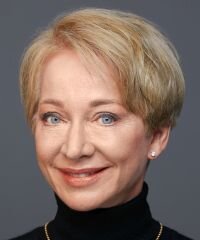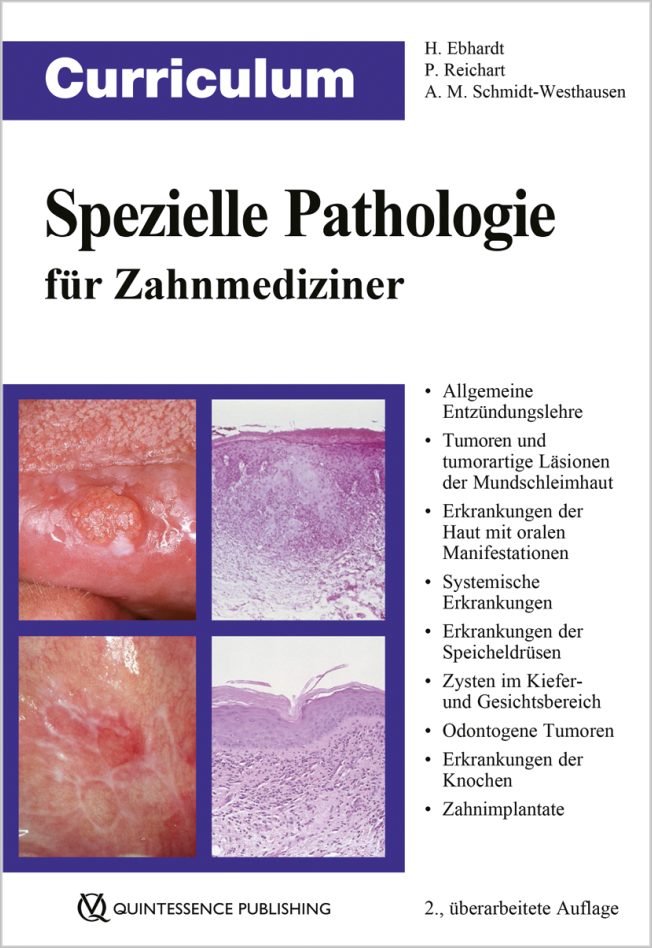Senioren-Zahnmedizin, 2/2020
Páginas 73-75, Idioma: Alemánvon Laffert, Alice / Schmidt-Westhausen, Andrea-MariaSowohl das bullöse Pemphigoid (BP) als auch das vernarbende Schleimhautpemphigoid (VSP) gehören zur Gruppe der Autoimmundermatosen. Das BP stellt hierbei die häufigste blasenbildende Autoimmundermatose dar, wobei hier die orale Mukosa nur selten (10 bis 30 %) betroffen ist. Beim VSP ist die orale Mukosa häufiger betroffen, insgesamt ist die Erkrankung jedoch deutlich seltener.
International Poster Journal of Dentistry and Oral Medicine, 2/2020
Póster 2208, Idioma: Inglés, AlemánMüller, Alice Josephine / Ebhardt, Harald / Schmidt-Westhausen, Andrea-MariaBackground: In this case report, we represent a healthy 26-year-old patient with an oral hairy leukoplakia who is HIV-seronegative.
Case presentation: The histological sample showed all typical signs for oral hairy leukoplakia, including balloon cells; however, the in situ hybridisation showed a negative result for an EBV infection, which is the common sign for oral hairy leukoplakia.
Conclusion: Therefore, we suggest the unusual diagnosis of "pseudo oral hairy leukoplakia" in this special case.
Palabras clave: oral hairy leukoplakia, HIV-negative, pseudo oral hairy leukoplakia
Senioren-Zahnmedizin, 1/2020
Páginas 33-35, Idioma: AlemánMüller, Alice / Schmidt-Westhausen, Andrea-MariaDie orale Candidiasis ist eine häufige opportunistische Infektion und wird durch Hefepilze der Gattung Candida (häufigster Erreger: Candidia albicans) ausgelöst. Die häufigste Form der Candidiasis, welche beim Hauszahnarzt diagnostiziert wird, stellt die Prothesenstomatitis dar.
Senioren-Zahnmedizin, 3/2019
Páginas 135-137, Idioma: AlemánMüller, Alice / Schmidt-Westhausen, Andrea-MariaDie Herpes Zoster-Infektion ist eine Viruserkrankung und tritt meist bei Patienten, die älter als 50 Jahre sind, auf. Die Primärinfektion durch die Varizella-Zoster-Viren (Windpocken) erfolgt zumeist im Kindesalter als Schmierinfektion, wobei die Varizella-Zoster-Viren lebenslang in Ganglien verbleiben und so bei verschiedenen Formen der Immunschwäche wie beispielweise Stress, Malignome, HIV-Infektion und Infektionskrankheiten oder immunsuppressiven Therapien zur Reaktivierung, dann als Herpes Zoster, führen können.
Senioren-Zahnmedizin, 2/2019
Páginas 74-76, Idioma: AlemánMüller, Alice / Schmidt-Westhausen, Andrea-MariaDie proliferierende verruköse Leukoplakie (PVL) ist eine seltene multifokale aggressiv-progrediente Form der Leukoplakie mit möglichem Malignitätspotential. Sie tritt am häufigsten bei Frauen (female: male ratio 4:1) im Alter von über 60 Jahren auf. Die Ätiologie der PVL ist unbekannt, eine Assoziation mit den klassischen Risikofaktoren Rauchen, Alkohol, HPV oder anderen Viren wird teilweise diskutiert, ist jedoch bisher nicht nachgewiesen.
Deutsche Zahnärztliche Zeitschrift, 3/2016
OriginalarbeitIdioma: AlemánSchmidt-Westhausen, Andrea-Maria / Daniel, Luisa / Ebhardt, HaraldDas orale Plattenepithelkarzinom zählt mit einer 5-Jahres-Überlebensrate von 59% der Frauen und 44% der betroffenen Männer zu den aggressivsten Karzinomen. Die Zahl der Neuerkrankungen in Deutschland steigt stetig an und manifestierte sich im Jahr 2008 mit 9520Initialdiagnosen unter Männern und 3490unter Frauen
The International Journal of Oral & Maxillofacial Implants, 6/2006
ID de PubMed (PMID): 17190306Páginas 951-956, Idioma: InglésStrietzel, Frank Peter / Rothe, Sven / Reichart, Peter A. / Schmidt-Westhausen, Andrea-MariaPurpose: Since 1997, the use of highly active antiretroviral therapy (HAART) has significantly improved systemic health and life expectancy of patients who test positive for the human immunodeficiency virus (HIV) in industrialized countries. Therefore, although implant-supported prosthetic rehabilitation has been restricted to immunocompetent individuals, it may be considered for these patients. Case Reports: The treatment course of implant-prosthetic rehabilitation in 3 patients is reported. Patient 1 (male, age 64 years) was under 4-drug therapy; patient 2 (male, age 38 years) and patient 3 (female, age 49 years) were under 3-drug therapy. Two patients had suffered from AIDS-defining diseases prior to HAART. Oral manifestations of HIV infection were not diagnosed throughout the observation period. Patients had CD4+ cell counts between 250 and 800/mL, and viral load was below 50/mL. Perioperative antibiotic treatment was not applied. Two patients presented with edentulous mandibles. In the third patient, single-tooth replacement of both mandibular first molars was performed. A total of 10 Frialit-2 implants were placed without augmentation procedures.
Results: One implant failed after 3 months and was successfully replaced. Two patients received magnet-retained overdentures in the mandible, and 1 patient was treated with single crowns. All implants and restorations are successfully in function. Neither radiographic nor clinical signs of inflammation were detected during the observation period (range, 7 to 32 months).
Conclusions: The outcomes of the 3 patients suggest that immunologically stable HIV-positive patients on HAART may be considered for implant-prosthetic rehabilitation.
Palabras clave: dental implants, HIV-positive patients, highly active antiretroviral therapy, immunocompromised patients, implant-supported prosthetic rehabilitation





